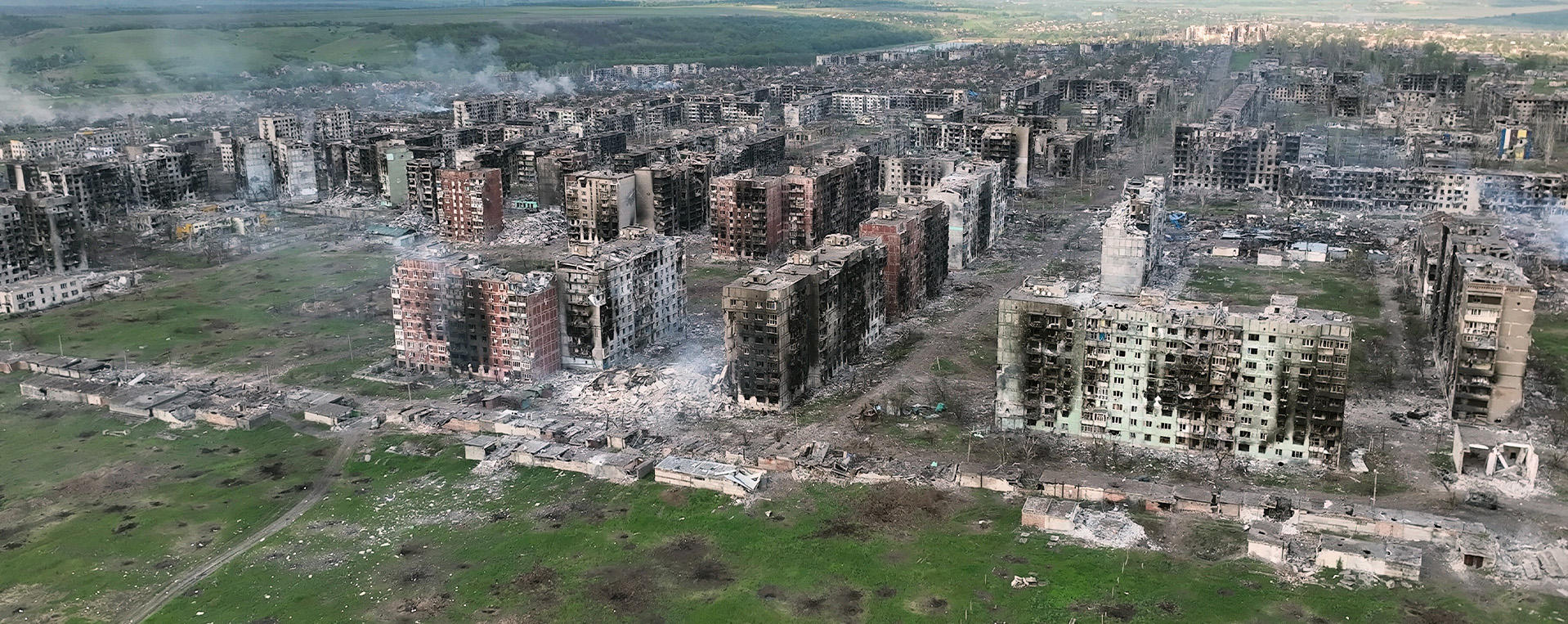Two years since the brutal invasion of Ukraine, fighting has left trail of death and destruction among many of the frontline towns and cities from the use of explosive weapons. Beyond the direct deadly impact from the blast, their use comes with a lesser known toll that is affecting public health and the environment civilians depend on. As around 85 states are meeting in Oslo this week to discuss the Political Declaration on Explosive weapons, a political commitment to better protect civilians against the impact from explosive weapons in towns and cities, PAX is releasing a new report that looks at the environmental risks associated with explosive weapons use.
Through the lens of six towns that faced severe destruction from the bombing and fighting, environmental risks are identified. The findings underscore the multilayered threats and complexity from urban destruction that comes with additional health burdens to civilians and long-term risks of environmental impacts. Using satellite imagery for damage assessments and open-source data, the findings demonstrate the widescale destruction of buildings, factories, energy and water infrastructure, health facilities and industrial sites that leave a toxic footprint in the wake of the fighting.
Each town analyzed in the report has a specific angle from destruction, ranging from industrial waste to massive amount of contaminated rubble and collapsed environmental governance. The report outlines specific risks assessments associated with the damages and how public health and the environmental can be affected from multiple pathways. With dozens of millions of tons of debris and rubble from damaged buildings, often mixed with asbestos and hazardous waste, first responders and civilians face additional health risks in the wake of the fighting. The destruction of water infrastructure and exposure to industrial toxics adds to the war woes that the population needs to deal with.
Over the next days, state and civil society representatives meet in Oslo to review state progress in implementing the Political Declaration on the Protection of Civilians from the Use of Explosive Weapons in Populated Areas. This is the first time states will meet since the agreement, aimed at reducing civilian harm, was adopted in Dublin in 2022.
The commitments include amongst other things that armed forces place limits on the use of explosive weapons in populated areas to avoid civilian harm, and in their policies and practices take into account the direct and indirect effects on civilians and civilian objects.
Wim Zwijnenburg, Project Leader Humanitarian Disarmament at PAX: ‘The impacts from explosive weapon use in towns and cities are multi-faceted and need to be understood in their full range to enable better protection for civilians.’ He adds: ‘Environmental effects from the use of explosive weapons in populated areas are often overlooked. With this report, we aim to contribute to an increased understanding of the impacts of explosive weapons and how to mitigate them.’
In the joint statement for the Oslo Conference, PAX and other civil society organisations underlined the importance of addressing the environmental consequences from the use of EWIPA.
More information
PAX work on environmental impact in Ukraine
This publication is part of a wider series of analyses on the environmental impact of war in Ukraine funded by the Netherlands’ Giro 555. Previous reports on Ukraine focused on attacks against energy infrastructure, agro-industrial sites, oil and gas infrastructure and the destruction of the Kakhovka dam, outlining the consequences of these attacks for the environment and public health.
Our research methods
As part of its work on addressing environmental dimension of the war in Ukraine, PAX works to improve data collection and analysis through open-source investigation and satellite imagery. These methods are key to deepen our understanding and knowledge of how wars impact the environment and people depending on it. The report is utilizing the findings of existing datasets and building on own research and novel remote sensing methods developed by academics to make quick risks assessments. This information is key for both local authorities, international organisations and raise awareness on the topic of protection of the environment in relation to armed conflicts.
The political declaration on Strengthening the Protection of Civilians from the Humanitarian Consequences arising from the use of Explosive Weapons in Populated Areas
The full text of the political declaration can be found here.
States that endorse the political declaration commit to work together, with the UN, ICRC and civil society, to strengthen the protection of civilians from explosive weapons. This requires action in a number of key areas, including:
- Commitment to impose limits on the use of explosive weapons in populated areas to avoid civilian harm – the centrepiece of the declaration.
- Commitment to address both the short- and long-term effects, resulting from the damage and destruction to civilian infrastructure.
- Provision to assist victims, including: people injured, families of those killed and injured; and conflict-affected communities.Requirement for states to collect and share data on civilian harm from explosive weapon use.
- Follow up meetings to review how the Declaration is being implemented and to share examples of military policy and practice, to protect civilians from explosive weapon use.
Endorsing states
As of 12 April 2024, it is endorsed by the following 86 states, including the Netherlands: Albania, Andorra, Argentina, Australia, Austria, Belgium, Bosnia and Herzegovina, Brazil, Bulgaria, Cabo Verde, Cambodia, Canada, Central African Republic, Chile, Colombia, Comoros, Costa Rica, Cote d’Ivoire, Croatia, Cyprus, Czech Republic, Denmark, Dominican Republic, Ecuador, El Salvador, Finland, France, Georgia, Germany, Greece, Guatemala, Guyana, Hashemite Kingdom of Jordan, Holy See, Hungary, Iceland, Indonesia, Ireland, Italy, Japan, Kenya, Kingdom of the Netherlands, Kiribati, Kuwait, Laos, Liberia, Liechtenstein, Luxembourg, Madagascar, Malawi, Malaysia, Malta, Mexico, Maldives, Monaco, Montenegro, Morocco, New Zealand, North Macedonia, Norway, Palau, Palestine, Peru, Philippines, Portugal, Qatar, Republic of Korea, Republic of Moldova, Romania, Saint Kitts and Nevis, Saint Vincent and the Grenadines, San Marino, Senegal, Serbia, Sierra Leone, Slovakia, Slovenia, Somalia, Spain, Sweden, Switzerland, Togo, Türkiye, United Kingdom, United States of America, Uruguay.
About the International Network on Explosive Weapons – INEW
INEW is an international network representing over 50 organizations in different countries around the world, that calls for immediate action to prevent human suffering from the use of explosive weapons in populated areas. PAX is one of the founding board members of the International Network on Explosive Weapons. See: www.inew.org
About the Explosive Weapons Monitor
The Explosive Weapons Monitor is a civil society research that conducts research and analysis on harms from and practices of explosive weapon use in populated areas for INEW The full 2024 report can be found here.




